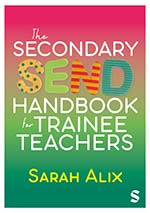The Secondary SEND Handbook for Trainee Teachers
February 2026 | 168 pages | SAGE Publications Ltd
This is your essential guide to special educational needs and disabilities in secondary schools.
It offers up-to-date information on policy and legislation to help you understand your role and responsibilities as a beginning teacher. It provides detailed guidance on the four broad areas of need set out in the SEND Code of Practice and how to support pupils whose needs sit within these categories. It explores informed ways to work with support staff, assess pupils' needs and the practicalities of Education, Health and Care (EHC) plans.
Packed with case studies drawn from real school experiences, opportunities for critical reflection, professional discussion topics and pupil support strategies, and linked directly to the Teachers' Standards and the Initial Teacher Training and Early Career Framework (ITTECF), this is a vital resource for your secondary teacher training.
It offers up-to-date information on policy and legislation to help you understand your role and responsibilities as a beginning teacher. It provides detailed guidance on the four broad areas of need set out in the SEND Code of Practice and how to support pupils whose needs sit within these categories. It explores informed ways to work with support staff, assess pupils' needs and the practicalities of Education, Health and Care (EHC) plans.
Packed with case studies drawn from real school experiences, opportunities for critical reflection, professional discussion topics and pupil support strategies, and linked directly to the Teachers' Standards and the Initial Teacher Training and Early Career Framework (ITTECF), this is a vital resource for your secondary teacher training.
Introduction: How to use this Book
Part One – Policy and Teacher Responsibilities
Chapter 1. Policy Development and Legislation in the UK Context
Chapter 2. The Role of the SENCo, Class Teacher and their Responsibilities
Part Two – Pupil Areas of Need
Chapter 3. Communication and Interaction
Chapter 4. Cognition and Learning
Chapter 5. Social, Emotional and Mental Health (SEMH)
Chapter 6. Sensory and Physical Needs
Part Three – Developing Classroom Practice
Chapter 7. Working with Support Staff, Education Professionals and Parents and Carers
Chapter 8. Assessing Pupil Needs through the Graduated Approach
Chapter 9. Education, Health and Care Plans (EHCPs)
Conclusion – The Future of SEND


